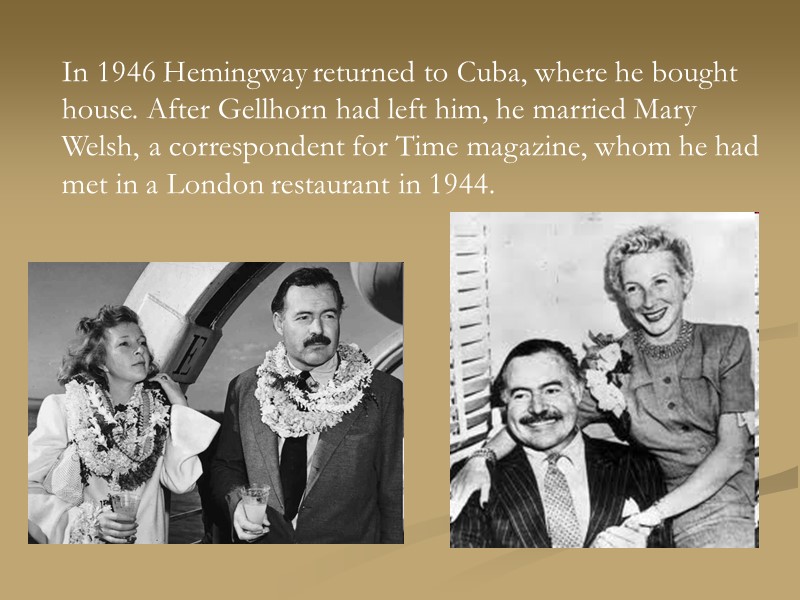Ernest Hemingway Ernest Hemingway was born on July


Ernest Hemingway

Ernest Hemingway was born on July 21, 1899, in Oak Park, Illinois. Hemingway's father took his own life in 1928 after losing his health to diabetes and his money in the Florida real-estate bubble.

Hemingway attended the public schools in Oak Park and published his earliest stories and poems in his high school newspaper. Upon his graduation in 1917, Hemingway worked six months as a reporter for The Kansas City Star.

Then he joined a volunteer ambulance unit in Italy during World War I. In 1918 he suffered a severe leg wound. For his service, Hemingway was twice decorated by the Italian government. On his first day in Milan, he was sent to the scene of a munitions factory explosion, where rescuers retrieved the shredded remains of female workers. He described the incident in his non-fiction book Death in the Afternoon: "I remember that after we searched quite thoroughly for the complete dead we collected fragments".

Hemingway's affair with an American nurse, Agnes von Kurowsky, during his hospital recuperation gave basis for the novel A Farewell to Arms (1929). The tragic love story was filmed first time in 1932, starring Gary Cooper, Helen Hayes, and Adolphe Menjou.

After the war Hemingway worked for a short time as a journalist in Chicago. He moved in 1921 to Paris, where wrote articles for the Toronto Star. "If you are lucky enough to have lived in Paris as a young man, then whenever you go for the rest of your life, it stays with you, for Paris is a moveable feast." (A Moveable Feast, 1964)

While traveling to Switzerland in 1922, Hemingway's first wife Hadley lost a piece of luggage, which contained everything he had written to date.

Hemingway's first books, Three Stories and Ten Poems (1923), of which he received no advance at all, and In Our Time (1924), were published in Paris. The Torrents of Spring (1926) was a parody of Sherwood Anderson's style.

Hemingway's first serious novel was The Sun Also Rises (1926). The story, narrated by an American journalist, deals with a group of expatriates in France and Spain, members of the disillusioned post-World War I Lost Generation.

On the same year Hemingway married Pauline Pfeiffer, a wealthy fashion editor, but at their first meeting, he had been more impressed by her sister Jinny. After the publication of Men Without Women(1927), Hemingway returned to the United States, settling in Key West, Florida. Hemingway and Hadley divorced in 1927.

In 1930s Hemingway wrote such major works as Death in the Afternoon (1932), a nonfiction account of Spanish bullfighting, and The Green Hills of Africa (1935), a story of a hunting safari in East Africa. "All modern American literature comes from one book by Mark Twain called Huckleberry Finn," is perhaps the most quoted line from the story. To Have and Have Not (1937) was made into a film by the director Howard Hawks.

Ernest continued write With To Whom the Bells Toll (1940) , novel Across the River and into the Trees and returned again in Spain.

In 1946 Hemingway returned to Cuba, where he bought house. After Gellhorn had left him, he married Mary Welsh, a correspondent for Time magazine, whom he had met in a London restaurant in 1944.

Hemingway's drinking had started already when he was a reporter, and could tolerate large amounts of alcohol. For a long time, drinking did not affect the quality of his writing. His ignorance of the dangers of liquor Hemingway revealed when he taught his 12-year-old son Patrick to drink.

In 1960 Hemingway was hospitalized at the Mayo Clinic in Rochester, Minnesota, for treatment of depression, and released in 1961. During this time he was given electric shock therapy for two months. He believed that FBI agents were following him, which was true: they had compiled a large file on him.

On July 2 Hemingway committed suicide with his favorite shotgun at his home in Ketchum, Idaho.
24816-ernest_hemingway.ppt
- Количество слайдов: 16

